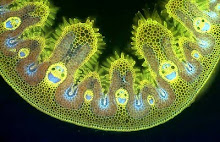My grandmother in Sussex used to grow Chinese lanterns Physalis alkekengi var. franchettii to perfection, but I've always struggled to grow them up here in North-East England, not least because the slugs and snails zero in on them almost as soon as new shoots appear in spring. Looking at the natural distribution of the plant - southern Europe and eastwards across drier parts of Asia, it's not surprising that I haven't been able to grow these well. Gran's garden was mostly flint and chalk and she grew them in a sun-drenched spot in gravel at the base of a south-facing bay window, which provided a fair approximation of the Mediterranean climate and soils that this plant enjoys.
The orange papery 'lantern' is formed from the sepals (collectively the calyx) of the flower that inflates once it has been pollinated, enclosing the....

......shiny red berry within. The dried plant makes a colourful winter decoration but if you leave some outdoors the softer parts of that inflated calyx rot away surprisingly quickly, so that by Christmas you have ....
... only the skeleton of veins left which - with a light spray of gold laquer - makes a delightfully intricate Christmas tree decoration.
There seems to be some taxonomic uncertainty surrounding this plant, which is sometimes known simply as P. franchettii. According to the late Graham Stuart Thomas - a gardener who really knew his perennials - P. franchettii has more pointed lanterns - like those in the first photo above - compared with the rounder P.alkekengi, in the skeletonised example above but, since he also mentions that they hybridise, it's reasonable to conclude that they are merely varieties of the same species.















